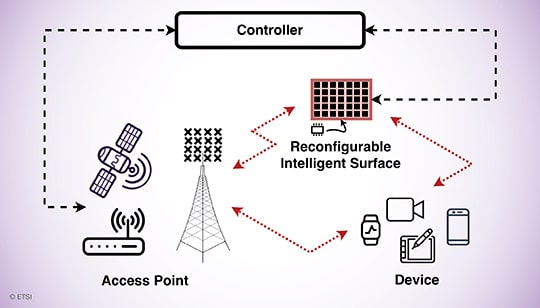European standards body ETSI recently announced the launch of a new Industry Specification Group on Reconfigurable Intelligent Surfaces (RIS). 6GWorld™ took the opportunity to go behind the story with Arman Shojaeifard, the Chair of this group.
The concept of Reconfigurable Intelligent Surfaces has been talked about in research circles for a few years now under a few different names including Reflecting Intelligent Surfaces, Large Intelligent Surfaces, Smart Repeaters, and Holographic Radios. Especially given the current push into mmWave spectrum and the potential for beyond-5G to reach into higher frequencies, we can already see difficulties with coverage and penetration.
An RIS, Shojaeifard explained, would be used as an additional network node to improve these attributes. “Particularly in indoor environments, where the propagation environment makes it very challenging for signal strength. One of the key use cases for RIS we hear about from operators is indoor environments…. This could be shopping malls, airports and businesses,” he suggested.

Indoor coverage extensions are not new, of course. Repeaters, relays and indoor cells have been enabling coverage for years. However, a RIS would be a passive node with minimal computing and energy demands. As a result, it would be a relatively cheap (and therefore more scalable) option.
“RIS by default is meant to be a passive type of node, where the software for handling the physical elements could be handled by something as simple as a microcontroller,” Shojaeifard explained. “These surfaces would have a very attractive quality in terms of hardware costs.”
Cost is not the only reason to deploy RIS, however, with the Industry Specification Group (ISG) exploring other use cases.
While some academics have hailed terahertz frequencies as an opportunity to integrate sensing and communications, Shojaeifard highlights that some applications of RIS could bring this into sub-6Ghz frequencies. This would enable sensing services such as fall detection in care homes without the need for high frequency spectrum. “There is certainly a strong interest in applying RIS in sub-6Ghz bands,” Shojeifard noted. “This is one of the main use cases many operators are asking about today.”
This may seem a very different concept from some of the descriptions of Large Intelligent Surfaces that industry-watchers may have heard about in the past year. This is a deliberate choice for ETSI, Shojaeifard commented, who wanted to ensure that they were talking very deliberately about a network node.
“This network node utilises the smart radio surface technology to dynamically control and shape the radio signals in the environment…. There is a clear control link from the network to the RIS component. The network would configure the RIS.”
In other words, a RIS might use technologies such as smart surfaces to achieve its ends, but it is the role of the RIS within a network that defines it.
First Steps
So, what does the roadmap for RIS look like? For an early-stage technology, ETSI is taking a measured approach that reflects the needs of the operators.
“A key mission for the ISG, especially in the early phase of the work, is to identify potential use cases for RIS technology. This is important for understanding where the technology could fit into the broader picture,” Shojaeifard explained.
“The ISG can focus on understanding and fine-tuning the models, the state-of-the-art and implementation side of RIS. All this will go into identifying gaps within standards in particular. Then the ISG can feed into those gaps with standards development organisations. This process is very important for progressing the technology from a research phase to being ready to go into a standard.”
Refreshingly, Shojaeifard avoids hype when talking about the technology and its deployment.
“We are likely to have the first products being quite simple – potentially focussing on backward-compatibility in sub-6Ghz bands. But eventually we are likely to see more capable types of RIS as part of the roadmap.”







